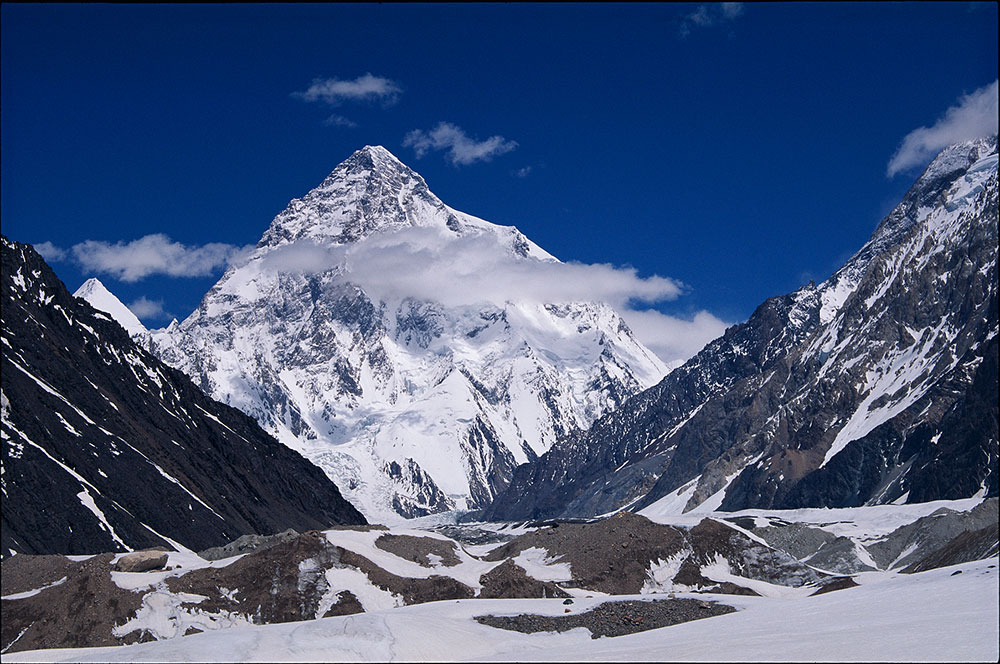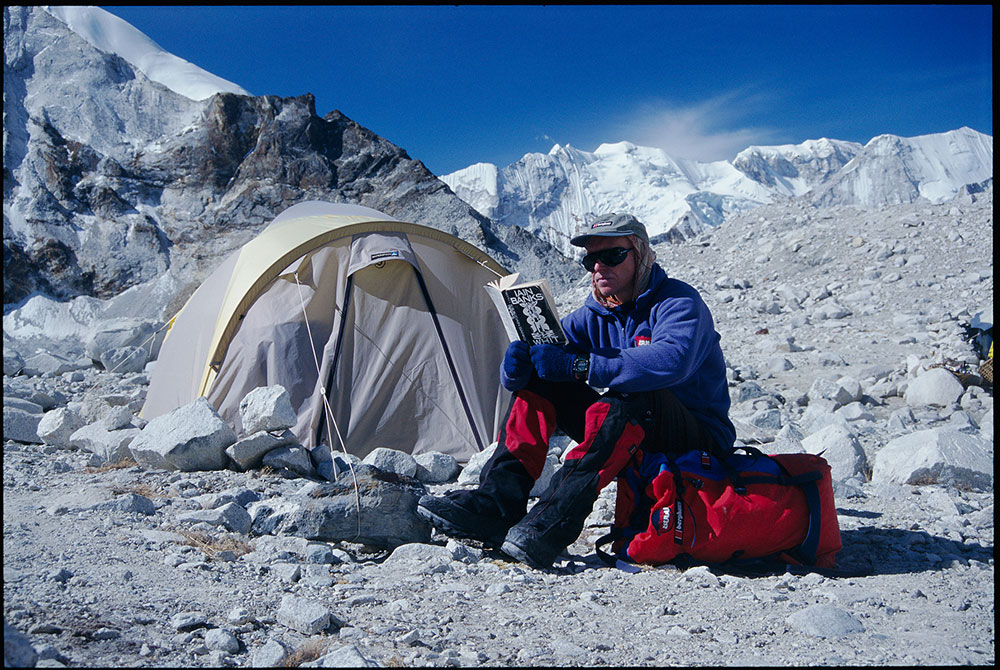It was the culmination of three consecutive expeditions. I had spent nearly 12 months over a three-year period attempting K2. Known as the Savage Mountain, it had, and still has, a reputation for difficulty and danger. K2 is not much lower than Everest, but it is much more difficult to climb. It is a more serious, arduous two-week trek to a remote BC, the weather is worse, the climbing is more technical and there are more avalanche and rock fall risks. Rescue is not really practicable, although the Pakistan military have flown helicopters to BC at 5200m. The realistic ceiling for helicopters is 6500m, above which the atmosphere is too thin for the rotors.
Straddling the Pakistan-China border in the northern Karakoram, it pokes up dramatically from the rock-strewn glacier. At 8611m K2 is a mountain of almost perfect proportions. It soars up over 3000m in a striking pyramid of ice, snow and rock. It is a mountain with no name, just the notation K for Karakoram and 2 because it was the second from the left when it was being surveyed in the early 1800s by the Great Trigonometrical Survey. It feels appropriate that this remote challenging mountain has the brief, stark designation K2.
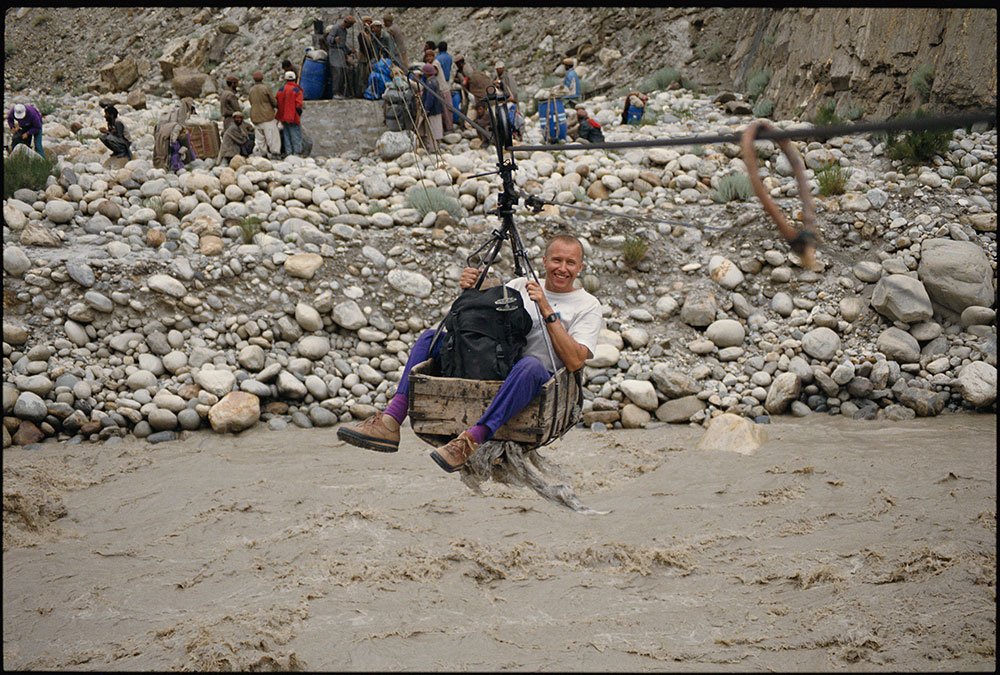 Crossing a river on the way to K2
Crossing a river on the way to K2
First attempt
My first attempt on K2 was abandoned to help rescue an exhausted climber. I was making a lightweight summit push with a mate & came across a stricken climber from another expedition. His partner had already fallen to his death down the 3000m south face. It was a simple decision to abandon the climb and rescue the injured climber. He was walking wounded, but needed support, we could not have carried him. It took both of us several days to guide him to BC. He was badly frostbitten, but survived with his toes amputated. After that I was too exhausted to go immediately back on the mountain. Unfortunately, the good weather window for the season closed and that was the end of that attempt.
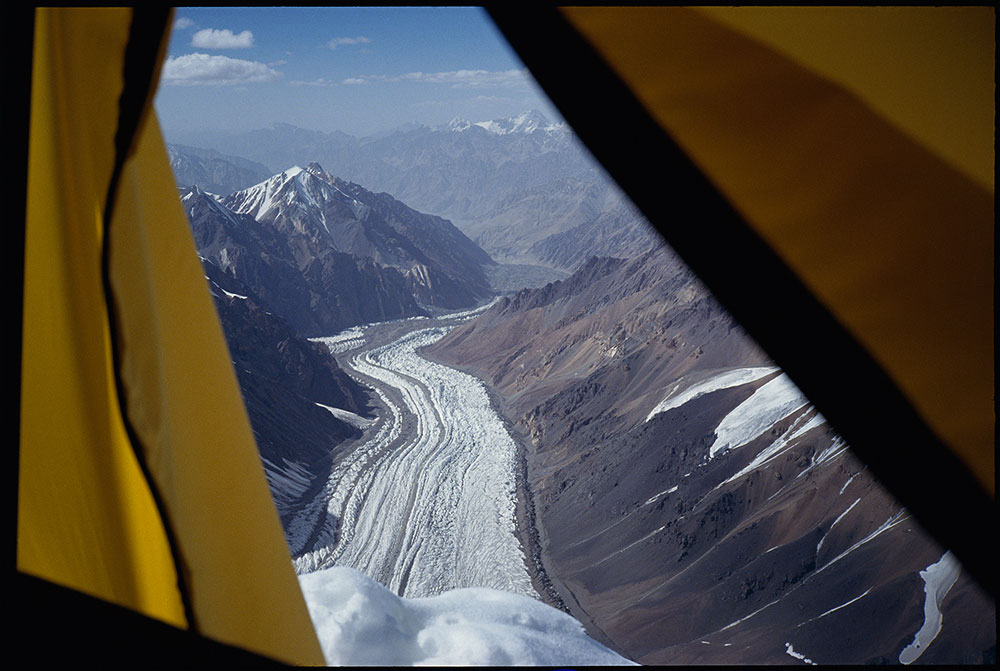 View from the tent with glacier 3000m below
View from the tent with glacier 3000m below
Avalanched
The following year I made an attempt on the remote north side from the Shaksgam area in China. This expedition was so remote that it lasted five months UK to UK. I had a close shave at 6000m when an avalanche struck the narrow bivouac ledge I was on. I managed to get out of my tent before it was flattened, but I was buried up to my thighs in wet snow which set like concrete. I was only in my underpants and freezing to death. Luckily, two of my teammates nearby were unharmed and dug me out. Otherwise, it would have been an ignominious, embarrassing end.
Later in June I was surprised when a Spanish-Italian expedition turned up. As this area is so remote I presumed we would have K2 to ourselves. I ended up making a solo attempt for the summit, spending 11 nights alone above 6800m. I knew I would be deteriorating and had to make a summit push. I reached a tiny ledge at 8100m and two of the Spanish climbers joined me. On the north side of K2, the final 500m is an exposed hanging glacier of steep ice and snow. It looked and felt very unstable and highly avalanche prone. I reached an altitude about five hours from the summit in clear, settled weather, but the risk of avalanche was too great and I turned back. The calculated risk was too high. Even though I had spent five months on this expedition, I was still prepared to turn back only five hours from the summit. I have a maxim: “No mountain is worth a life. Coming back is a success. The summit is only a bonus.” Tragically the two Spanish climbers carried on and the slope did avalanche.
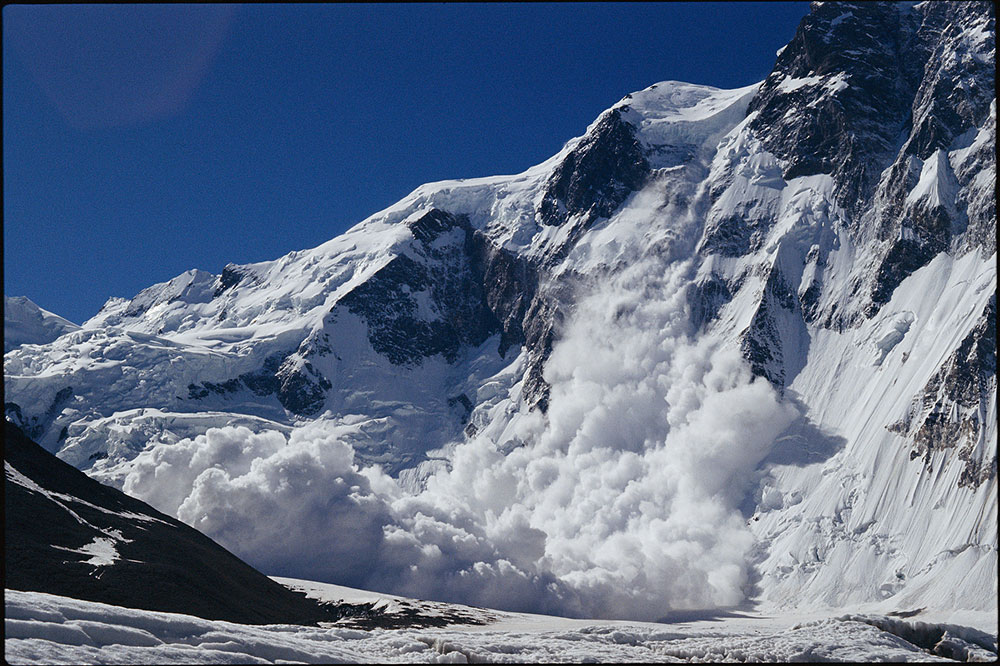 Avalanche on north face K2 roaring down 3000m 10000 face
Avalanche on north face K2 roaring down 3000m 10000 face
Back for a third go
I planned for my third attempt on K2 in June/July 1995. Unfortunately, in April 1995 I had a serious leg injury after slipping off the path trekking in to Makalu. A tree stopped me plummeting 60m to my death, but a branch ripped into my leg like a medieval spear. The branch narrowly missed my femoral artery, otherwise I would have bled to death and luckily missed other vital private parts; otherwise, I might have been singing soprano.
I was five days into the ten-day trek to BC, five days from the nearest road head, which was three days further to Kathmandu. Fortunately, I had a good contact in Kathmandu who sent a helicopter the following day. My leg was in a serious state and badly infected. I was transferred to Bangkok for surgery and spent most of April alone in hospital.
This serious incident was caused by complacency. I let my guard down, thinking that the trek to BC is only a bimble and I do not need to be aware of the dangers like when I am climbing on the mountain. It was a salutary lesson to never underestimate any mountain experience.
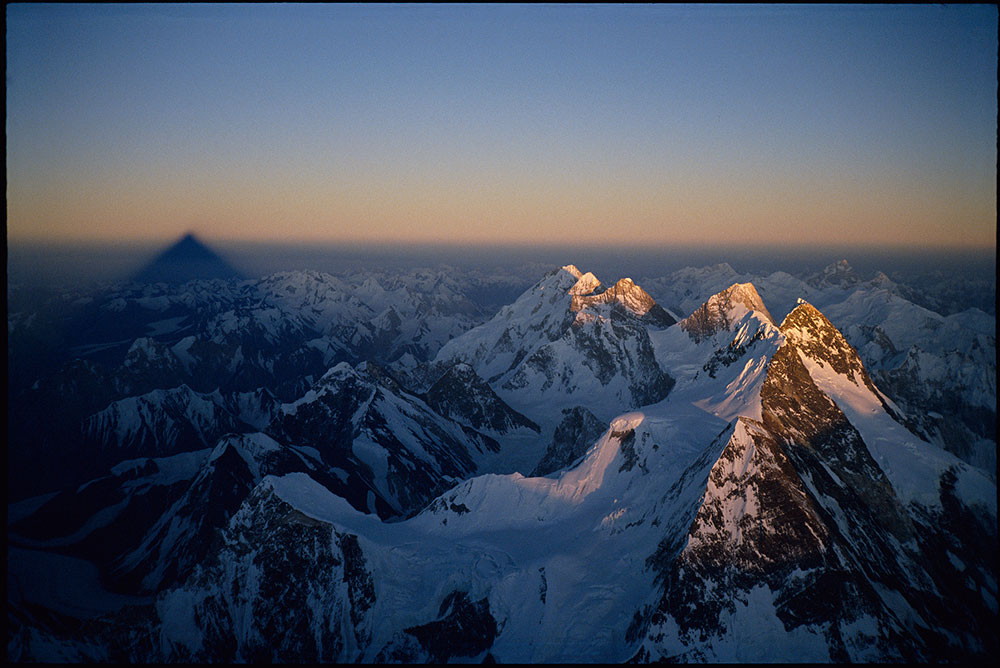 Shadow of K2 from summit as sun sets
Shadow of K2 from summit as sun sets
My leg healed well and I was ready for K2. I teamed up with Alison Hargreaves and we set off together to join the 1995 American K2 expedition. I knew Alison well, she was an old friend and we had climbed together a lot, especially in winter on Ben Nevis. We trekked in for twelve days and climbed together for two weeks, acclimatising on the mountain, before changing to an American climbing partner. This was my third attempt on K2 and I was focussed and determined to summit. I had a lot of local knowledge of the mountain and area. Also, this was my thirteenth 8000er expedition and I had summited four 8000ers. At that time, I was the most experienced mountaineer in the area. I still had my mantra, that no mountain is worth a life, coming back is as success, the summit is a bonus.
An old Friend
K2 felt like an old friend, it did not faze me, I felt confident, although I was acutely aware of the dangers it posed and knew that I must not get complacent and underestimate the risks on what was becoming familiar terrain.
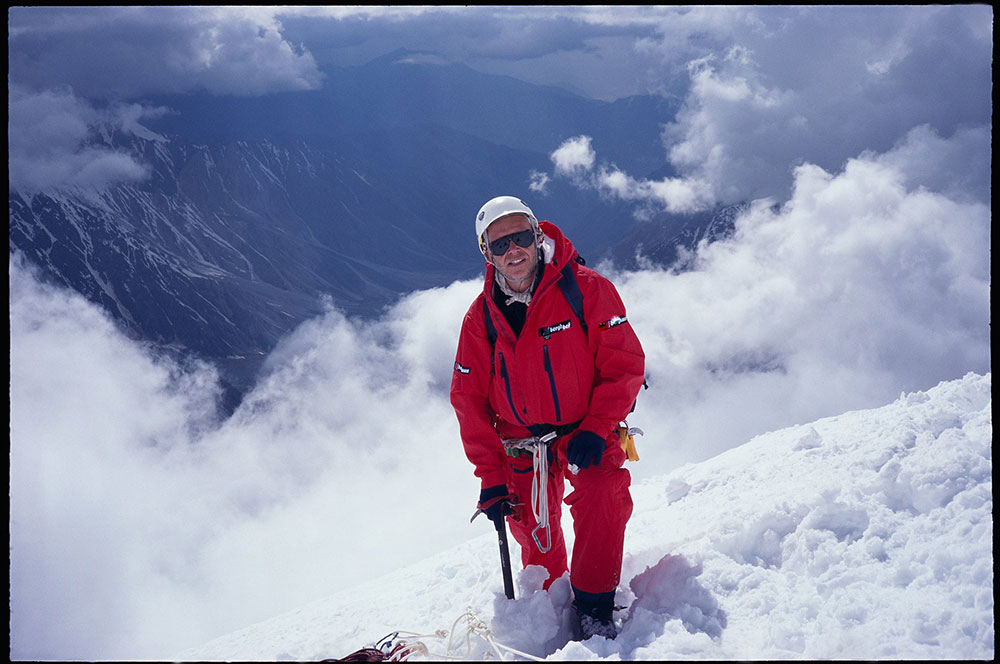 Above the clouds. Wearing Hinkes suit specially designed oversuit for high altitude climbing
Above the clouds. Wearing Hinkes suit specially designed oversuit for high altitude climbing
I was fit, ready and felt a sense that a good weather window was opening. I knew I had to go for it. My American climbing partner had to drop back as he was not acclimatised enough and I pushed on alone. I reached the top solo at the same time as two Dutch and two Pakistani climbers on 17 July 1995. It took me 15 hours from my last bivouac on the shoulder at 7900m and I descended in the dark back, to the shoulder, overtaking the Dutch and Pakistani climbers. Luckily as my senses had suggested the weather held and I descended to BC the following day. I was elated but utterly exhausted. Sadly, Alison perished in a storm a couple of weeks later. That year only five people summited and survived and eight were killed. K2 truly can be The Savage Mountain.
All images © Alan Hinkes

